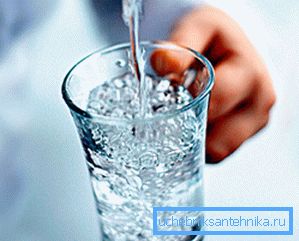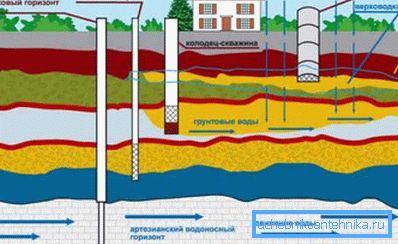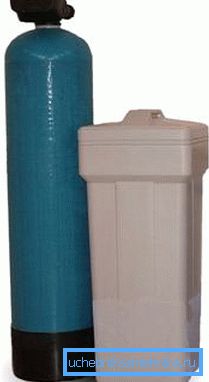What could be the water from the well
For food needs, in many cases, people use well water - this also includes using a common water supply network. The development of aquifers is carried out on different layers and usually they can be located at a depth of 10 to 250m and even more.
Below we will talk in more detail on this topic, and also see the thematic video in this article.

About wells
What is the difference

- There are two main types of wells - artesian and on the sand (the temperature of the water from the well depends on their depth). In the first case, they are reliably protected from surface contamination, since their calcareous aquifer is located between two waterproof layers that exclude ingress of liquid elements. Based on the location, such waters can be called the cleanest, although they often contain manganese and iron, but sand or sand does not get there.
- Drilling on sand is less in depth and affects only sand horizons, but at the same time GOST 17.1 3.03-77 The rules for selecting and assessing the quality of sources of centralized drinking water supply are respected. That is, here we have in mind the instructions on the organic composition of water that can not harm human health. The problem of such drilling is in operation - screening filters are needed here and, moreover, the shelf life of such a well is on average 5 years, although it is subject to recovery by cleaning.
- Depending on the power source, the well's capacity for water may be different - it takes into account the possibility of fluid recovery during its withdrawal within one hour and this is called the flow rate. For example, when drilling an artesian, the head of a column can be so intense that the water will be keyed, without being forced (without using pumps). However, in almost all cases, submersible (deep) pumps of different capacity (capacity) are used for water intake.
Recommendation. Each aquifer or even its separate section may differ significantly from its own kind. Therefore, the examination of a well for water is extremely important, which will determine the chemical composition of water and its suitability for food consumption in general.
Use filters to clean

Often, a simple man in the street wonders how to soften water from a well, which is located on its site or on the border with its neighbors, if the arrangement was carried out.
This problem concerns not only the private sector, but also industrial and civil construction, but in such cases special softeners are used. For home use, these units can match the performance from 0.2 to 10m3/ hour or even 20m3/ hour, but for industrial capacities apply devices from 30m3/ hour and more.
Softening occurs due to the effect of cation exchangers on ions of iron, magnesium and / or calcium, which are replaced by ions of sodium or hydrogen. Cation exchangers can be sodium (Na-form) and hydrogen (H-form), therefore, the replacement of ions depends on this form. In most cases, for the commercial and domestic needs are used units with the Na-form, and you can install them by hand, without the involvement of specialists.

But is it possible to drink water from a well, if it is with sand or silt - even if it does not damage your health, then, in any case, it is simply unpleasant, therefore, in such cases, special types of filters, slit and mesh, are used.
For pebbles and limestones or for artesianism, filters in the form of a perforated steel pipe (a hole in the form of a circle or a slit) are used, where the throughput zone is 20% -25%. For drilling wells on the sand apply mesh filters (mesh pipe), the capacity of which is 40% -60%.
But the presence of a slit or mesh filter is not always sufficient, and even checking the water from the well itself can show that it has some kind of odor or unpleasant taste. Although, of course, it is best to conduct a laboratory chemical analysis, but sometimes these or other impurities are simply obvious, so you know that you need to remove their water to clean it.

If you have found it necessary (or this is the conclusion of a laboratory analysis) to additionally purify water, then such downhole filters are usually placed in front of the water-folding unit, that is, before distributing the water supply system by points. There are three main types of cleaning - 1) reagent, 2) non-reagent and 3) complex method.
Each of them has its advantages, as well as its own disadvantages.
- The first method removes unwanted impurities from the composition of water by their interaction with chemical elements. In this case, the dosage of reagents is carried out manually or automatically, and they are located in front of the filter. For domestic needs, this is the Na-form, which also contains chlorine and this, perhaps, can be attributed to the disadvantages.
- Of course, the reagent-free method does not have a similar chemical asset, and cleaning here is carried out using oxygen contained in air (ferrous iron dissolved in water, turns into trivalent, that is, rust) and subsequent sedimentation at the bottom of the tank. The disadvantages here are the low rate of precipitation of rust, but the price of such a device is minimal, and it can be done independently. These devices also include ultraviolet disinfectants.
- The complex method contains the two methods described above and is the most effective. In addition, the filter is used here again after washing it with saline.
Note. Despite the prevailing opinion about the dangers of iron for the body contained in water, it is not quite so. The threat is its content of more than 0.3 mlg / l, which happens very rarely. But rust in itself can cause allergic complications.
Conclusion
It is up to you to decide how to test the water from the well - to give it for laboratory analysis, ask the neighbors about it or simply trust your own intuition. But in any case, you need to make every effort to ensure that the water in your faucet is clean.